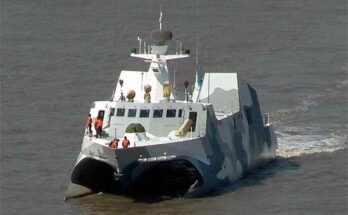Canada recently announced that it would procure a sixth Arctic and Offshore Patrol Ship (AOPS), but the ship could be twice as expensive to build as the previous ships in the class. The patrol ships cost approximately CAD400 million each, but the sixth ship will cost as much as CAD800 million, according to new reports. Part of the reason for the increased cost is that Canada is stretching out the AOPS construction schedule in order to prevent a gap in work for Irving Shipbuilding ahead of construction of the new Canadian Surface Combatant, which is replacing the Royal Canadian Navy’s Halifax frigates and former destroyers.
Approximately CAD150 million will be required to extend the AOPS production schedule, while CAD250 million will cover fluctuating labor rates, increased projects costs, and other miscellaneous costs. The sixth ship will add two years to the construction timeline. Under the original schedule, the fifth ship would have been delivered by the end of 2022, but now that date has been pushed back by one year. The sixth ship will arrive in winter 2024.
The original AOPS contract only guaranteed delivery of five ships, but allowed for construction of a sixth ship if the shipbuilder could find enough savings within the existing program budget. Those savings were not realized, and the sixth ship is being pursued only to keep the shipyard active. Of note, Irving was actually pushing the government to build two additional patrol ships, and has sought additional work on Halifax frigate maintenance. The first patrol ship was launched in September.
The @RCN_MRC future @HMCSHarryDeWolf is launched!Congratulations to our shipbuilders on this exciting #AOPS and National Shipbuilding Strategy milestone. pic.twitter.com/E1rSONgHdm
— Irving Shipbuilding (@IrvingShipbuild) September 15, 2018
Military officials have said that the added expense for the AOPS will pay off in the long-run, because the shipbuilder won’t lose skilled workers ahead CSC construction. The argument is that a lull in work at the shipyard would result in layoffs, and that hiring and retraining personnel would increase costs for the CSC program. Portions of the surface combatant construction may also be started earlier than planned in an effort to avoid any construction gaps.
Canada recently selected the Type 26 frigate as its preferred options for the CSS program. A contract has not yet been awarded for those ships. The preferred bidder status for the winning Lockheed Martin/BAE Systems team means that negotiations between the government and the industry team will commence with the intention of awarding a construction contract in winter 2019. Construction would begin in the early 2020s. At one point, Canada had hoped to have a new surface combatant in the water as early as 2014/2015, but the program fell significantly behind. The delay has not only increased shipbuilding costs as described above, but has left Canada without a critical capability after the retirement of its Iroquois class destroyers before a replacement was ready.
As editor of International Military Markets, North America, Shaun has cultivated a deep understanding of the vast defense markets in the United States and Canada. Shaun's perspective on defense procurement and budget issues has been cited in a variety of defense periodicals, including Defense News and National Defense Magazine. Further, Shaun played an integral role in the development of Forecast International's U.S. Defense Budget Forecast product, which offers an unprecedented level of insight into the Pentagon's acquisition budget. In addition to providing original analytical content for the U.S. Defense Budget Forecast, Shaun oversees an internal defense budget forecasting process involving Forecast International's team of skilled systems analysts following release of the DoD's annual budget request. Shaun is also in charge of managing Forecast International's Weapons Inventory database.




